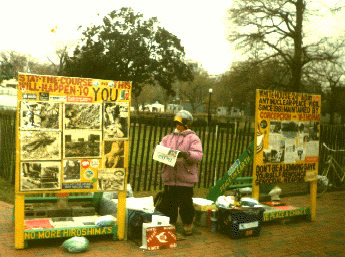Saturday, March 19, 2011
PLEASE VISIT AND SPREAD THE WARNING- Concepcion Picciotto - White House Anti-Nuclear Peace Vigil Hijacker from Founder W. Thomas
PLEASE VISIT AND PROMOTE - Concepcion Picciotto - White House Anti-Nuclear Peace Vigil Hijacker from Founder with W. Thomas
Wednesday, March 16, 2011
Mr. President, meet your closest neighbor
Introduction
Mr. President, meet your closest neighbor: Concepcion Picciotto.
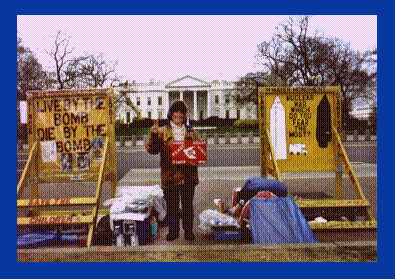
The tourists come and go on Pennsylvania Avenue; the presidents, the inaugurations, the dignitaries and the political scene is always changing. But some things remain the same in Lafayette Park, across the street from the White House in Washington, D.C.
She stands directly in front of the White House; she has been called "The Little Giant", a paradox, a mystery. Concepcion Picciotto is one who stays; through the rain and snow, the arrests, the abuses and threats through the years. Since 1981, Concepcion, or 'Connie' to her friends, has continued a vigil for world peace against the proliferation of weapons of mass destruction ; and that she would still be here 26 years later

The tourists come and go on Pennsylvania Avenue; the presidents, the inaugurations, the dignitaries and the political scene is always changing. But some things remain the same in Lafayette Park, across the street from the White House in Washington, D.C.
She stands directly in front of the White House; she has been called "The Little Giant", a paradox, a mystery. Concepcion Picciotto is one who stays; through the rain and snow, the arrests, the abuses and threats through the years. Since 1981, Concepcion, or 'Connie' to her friends, has continued a vigil for world peace against the proliferation of weapons of mass destruction ; and that she would still be here 26 years later
Tuesday, March 15, 2011
The Vigil: Past To Present
The Vigil: Past To Present
The following excerpts are from the many articles that have been written by sympathetic and malicious reporters alike to give you a real PIECE OF HISTORY. I'd like to take this opportunity to Thank the many publications and supporters over the years who have contributed their ideas, energy, and compassion to keep the vigil going. Any representation of articles is for the purpose of exhibiting the TRUTH, and to tell the story only, not for any personal gain. This web site has been contributed by friends. Sincerely, Concepcion Picciotto.
March 1, 1997.
Reflections of the Past: The Early Years
In The Beginning: (Just click the article nameif you want to read the rest of the story.)Connie and Thomas Call Sidewalk Home
PATIENT PROTESTERS CALL SIDEWALK HOME

TUESDAY, OCTOBER 12, 1982 By Kathleen Tyman
WASHINGTON TIMES STAFF
Connie's Beloved Thomas' 'MANIFESTO OF INDEPENDENCE'
MANIFESTO OF INDEPENDENCE:
A FAST FOR LIFE, LIBERTY
AND THE PURSUIT OF HAPPINESS
by William Thomas
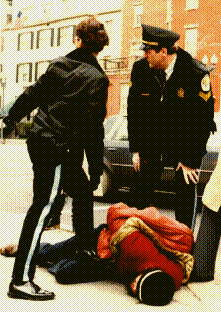
Then Concepcion and Thomas met their good friend and mentor, Norman Mayer, click picture below for story.
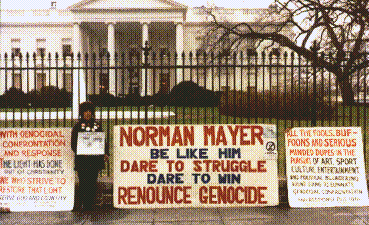
Norman gave them the courage to make more and bigger signs:
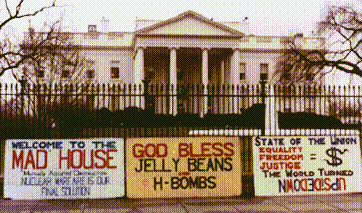
Connie's Dear Friend Norman Mayer Slain - Vigil Continues
THE PROTEST GOES ON
Houston Chronicle March 13, 1983BY MONA MEGALLI
United Press International Sympathizers with demonstrator who was slain at White House continue their anti-nuclear vigil
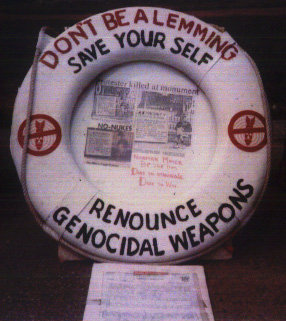
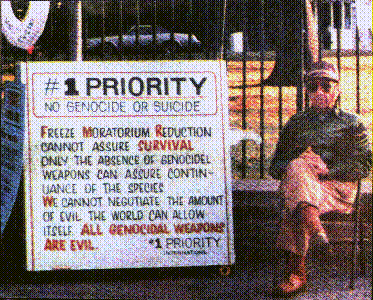
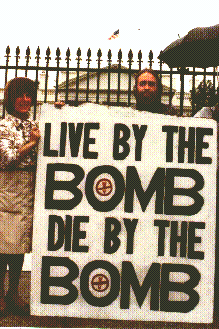
Connie and Thomas Legal Battles Con't
Judge Lifts White House Picket Rules
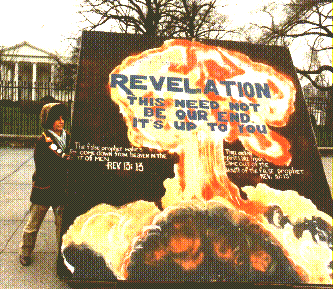 The Washington Times
The Washington TimesTHURSDAY, MAY 5, 1983
By David Sellers
Washington Times Staff
"I don't think there's any justification for not having that 30-day period:' Bryant said. "There's no articulated exigency."
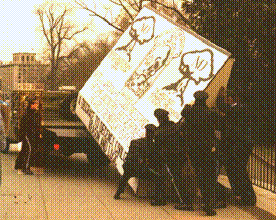 In spite of their resistance, the Park Police and the Secret Service won the battle, and the protesters were forced off the White House Sidewalk:
In spite of their resistance, the Park Police and the Secret Service won the battle, and the protesters were forced off the White House Sidewalk: 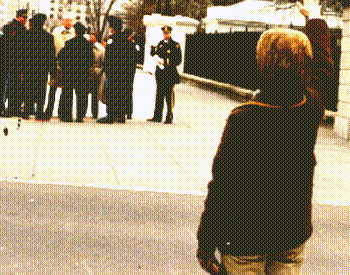 Concepcion salutes the Park Police, Hitler-style, as they take the signs away.
Concepcion salutes the Park Police, Hitler-style, as they take the signs away."It was disgraceful," she remembers.
Protesting on the White House Sidewalk had come to an end. A new way of life began for Thomas and Concepcion:
Conchita's Signs Taking Root in Lafayette Park
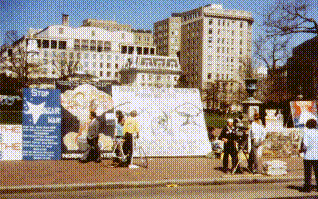
SIGNS TAKING ROOT IN LAFAYETTE PARK
THE WASHINGTON TIMES
August 8,1984
Connie and Thomas - Watchers at the Gate
WATCHERS AT THE GATE
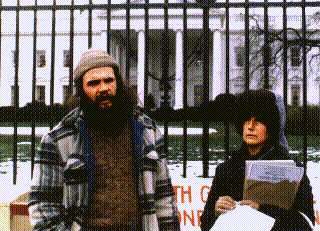 THE NORTH IRELAND TIMES
THE NORTH IRELAND TIMESTHURSDAY, AUGUST 8, 1985
Beaten, abused, living rough, they stand like some moral Maginot Line on a permanent White House peace vigil..
The man and the woman -Concepcion Picciotto and William Thomas - live under the stars, exposed to the rain and snow, summer and winter, without tent or sleeping bag. They feed like the pigeons and squirrels in the park, on what comes along, sometimes from the nearby McDonald's or Hardees bins.
Connie Advertising a the White House?
Advertising at The White House!?
Word of Mouth,Inc. A Newspaper
Dedicated to the Population Majority
VOLUME III An International Publication Based in Jacksonville,Florida,USA
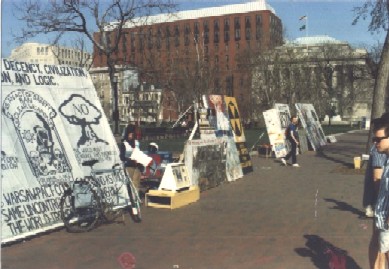
........ a very powerful advertising campaign was launched in Washington, District of Columbia, more than three years ago. The marketing director was one of the growing number of women in the business of public relations. Except that she was hired to do a huge campaign, -- with no prior experience! She got the job due to connections. So, she was offered only the experience of the job itself--with no salary.
Concepcion's Life of Protest
A LIFE OF PROTEST
By George Joseph Tanber
TOLEDO MAGAZINE, Decmber 4-10, 1988

Conchita's Round the Clock Vigil
A WOMAN'S ROUND THE CLOCK
PEACE VIGIL
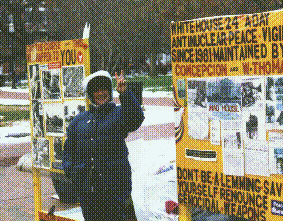
Daily Express
Malaysia
Sunday, Sept. 19, 1993
From James Sarda
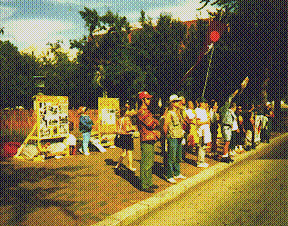
"People just want to be heard'" Concepcion added;
Connie - Proof that if you keep trying, some will listen
Concepcion has learned that if you keep trying, some people do listen:
Reflexion grafica por Sally Hanlon:
Revista Maryknoll, March 1992 Cargando la cruz ajena
 Concepcion Piccioto, oriunda de Espana, lleva 10 anon dia y noche frente a la Cas Blanca en vigilia permanente por la paz?
Concepcion Piccioto, oriunda de Espana, lleva 10 anon dia y noche frente a la Cas Blanca en vigilia permanente por la paz? Concepcion Picciotto, a native of Spain, has spent 10 years [97: now 16 years] of her life in front of the White House day and night in a permanent vigil for peace.
What will I contribute to peace?
Conchita - Inspiring Peace Activists World-wide
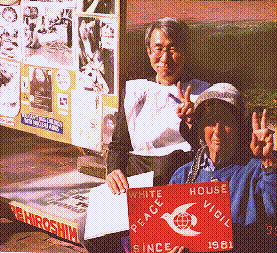
Connie - "We must teach our children to value Life"
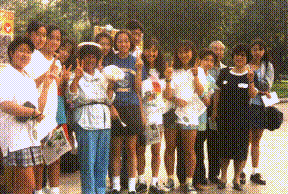
Concepcion - No More Hiroshimas

No More Hiroshimas
One of Concepcion's Fliers depicts the little girl, Sadako Sasaki, who died on October 25, 1955, from leukemia, "the bomb sickness", which killed many for years after the war. This statue was erected in Hiroshima Peace Park, in 1958, in memory of Sadako and the thousands of children who died at Hiroshima. Sadako is holding a golden crane in outstretched arms atop a granite mountain. The legend in Japan is that if you fold a thousand paper cranes, the angels will grant your wish. Every year, on August 6 --Peace Day, children come from all over the world to place paper cranes at the base of the statue.
Connie, an Unmatched Defender of Free Speech - 1st Amendment
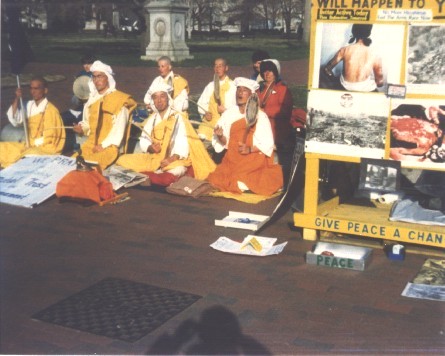
The "Regulations" being implemented by the National Park Service have slowly, subtly, consistently pushed the First Amendment frontliners to the back of the park, away from the White House and the tourists, but the Park Police don't let up.
After Clinton's second Inauguration, we moved the signs back to the front of the White House, as we have done since Reagan's second term. The Park Police were rude, and said, "No, you can't move those signs until the supervisor gives the order."
Thursday, January 20, 2011
Washington Post - Whatever Happened To... ... the protesters at Lafayette Square park?
http://www.washingtonpost.com/wp-dyn/content/article/2011/01/21/AR2011012105339.html
By Kris Coronado
Sunday, January 30, 2011  After gazing at the White House, a group of well-dressed tourists turns around and takes in an entirely
After gazing at the White House, a group of well-dressed tourists turns around and takes in an entirelyProtester Concepcion Picciotto holds a poster depicting William Thomas. (Benjamin C Tankersley - )different scene across the street. There, centered on the sidewalk along Lafayette Square park, is a jumbled menagerie of wooden and cardboard signs. One shows photos of Hiroshima bombing victims. The caption reads: "Stay the course and this will happen to YOU."
When the onlookers approach for a better view, they catch the attention of Concepcion Picciotto -- the woman to whom this anti-nuclear vigil belongs.
She is rearranging her signs. The previous day, U.S. Park Police briefly relocated her to the northwest corner of the park when they closed it to the public for undisclosed reasons.
"It's so hard," Picciotto explains. "For two hours, they made us move everything and wait."
A 40-something tourist smiles condescendingly. "That's a good idea, though, because you wouldn't want one thing to be in a spot for too long," she says.
Picciotto is not amused. "Well, I have this here for you because you do nothing," she retorts. "You people go around like robots with cameras. If you people were more concerned, we wouldn't have to be here."
The group scoffs and mockingly makes robot movements before walking away laughing.
This is no joke for Picciotto. She has been staging her protest against nuclear weaponry every day since 1981. On this windy winter morning, her petite frame is bundled in a thick corduroy jacket. She wears a scarf over a wig, and many of her front teeth are missing.
When featured in The Washington Post in June 2006, Picciotto left the talking to William Thomas, the man who began the vigil on June 3, 1981. Picciotto had met Thomas a few months earlier and decided to join him.
The pair had regulations to follow -- they couldn't stray three feet from their property or sit in anything resembling bedding. Thomas was arrested multiple times.
Yet all of these challenges seemed negligible in comparison to the one Picciotto faced on Jan. 23, 2009 -- the day Thomas succumbed to pulmonary disease at age 61. With her compatriot gone, how could she maintain the vigil on her own?
That's when Start Loving (yes, he goes by that name only) stepped in.
"I was just unwilling to see it jeopardized," says Loving, a fellow activist.
Loving's presence in the mornings and evenings means Picciotto can grab a shower or relieve herself.
For now, Picciotto will maintain her vigil for a nuclear-free world. There's no apparent end, she insists. To this day, no president has crossed the street to meet her. It's a fact she finds frustrating. "I'm very discouraged," she says.
She is rearranging her signs. The previous day, U.S. Park Police briefly relocated her to the northwest corner of the park when they closed it to the public for undisclosed reasons.
"It's so hard," Picciotto explains. "For two hours, they made us move everything and wait."
A 40-something tourist smiles condescendingly. "That's a good idea, though, because you wouldn't want one thing to be in a spot for too long," she says.
Picciotto is not amused. "Well, I have this here for you because you do nothing," she retorts. "You people go around like robots with cameras. If you people were more concerned, we wouldn't have to be here."
The group scoffs and mockingly makes robot movements before walking away laughing.
This is no joke for Picciotto. She has been staging her protest against nuclear weaponry every day since 1981. On this windy winter morning, her petite frame is bundled in a thick corduroy jacket. She wears a scarf over a wig, and many of her front teeth are missing.
When featured in The Washington Post in June 2006, Picciotto left the talking to William Thomas, the man who began the vigil on June 3, 1981. Picciotto had met Thomas a few months earlier and decided to join him.
The pair had regulations to follow -- they couldn't stray three feet from their property or sit in anything resembling bedding. Thomas was arrested multiple times.
Yet all of these challenges seemed negligible in comparison to the one Picciotto faced on Jan. 23, 2009 -- the day Thomas succumbed to pulmonary disease at age 61. With her compatriot gone, how could she maintain the vigil on her own?
That's when Start Loving (yes, he goes by that name only) stepped in.
"I was just unwilling to see it jeopardized," says Loving, a fellow activist.
Loving's presence in the mornings and evenings means Picciotto can grab a shower or relieve herself.
For now, Picciotto will maintain her vigil for a nuclear-free world. There's no apparent end, she insists. To this day, no president has crossed the street to meet her. It's a fact she finds frustrating. "I'm very discouraged," she says.
Subscribe to:
Posts (Atom)
